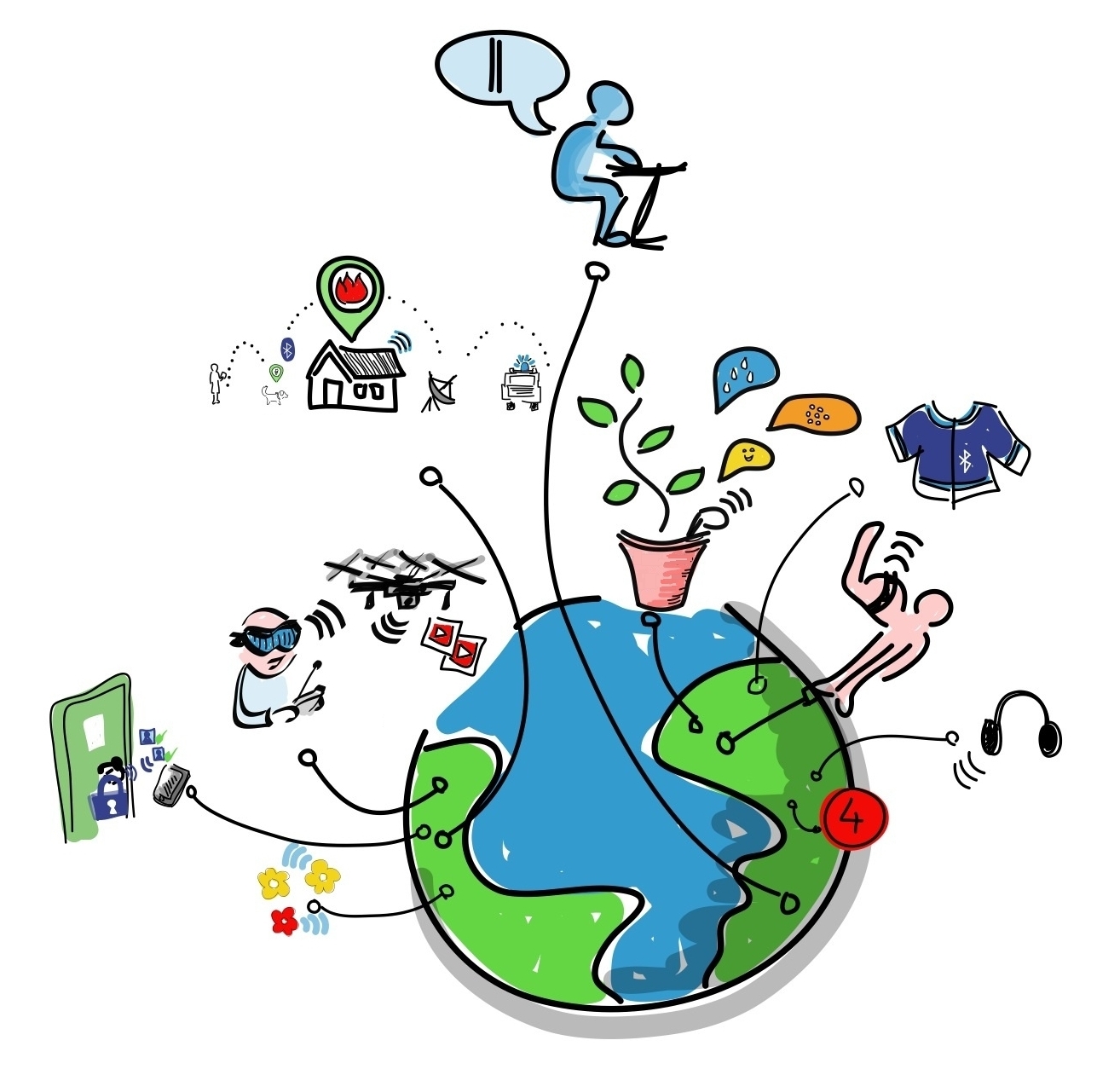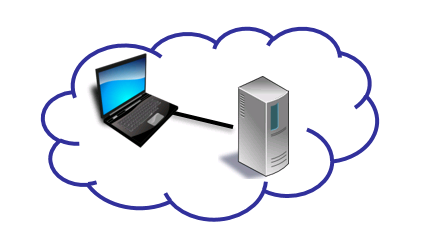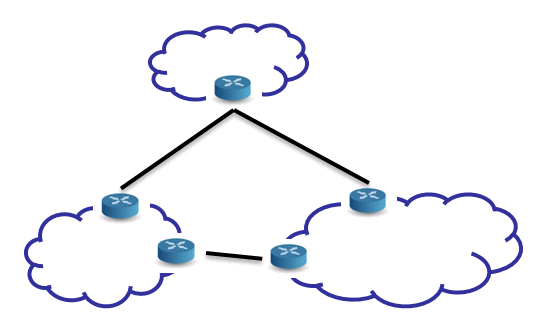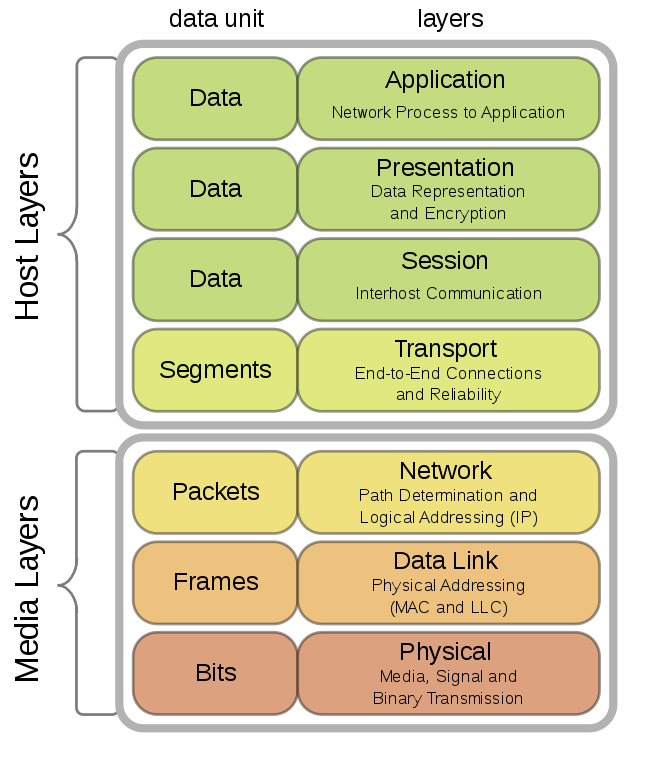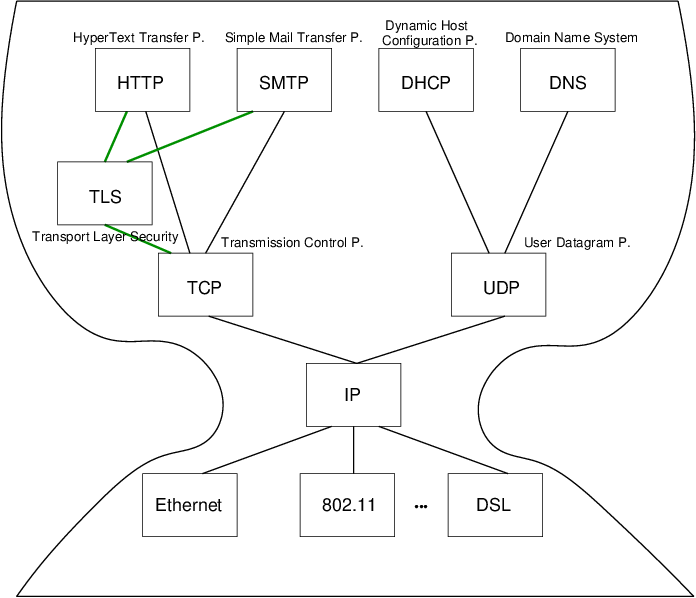The Internet
(Usage hints for this presentation)
VM Neuland im Internet 2021
Dr. Jens Lechtenbörger (License Information)
Agenda
1 Introduction
1.1 Today’s Core Questions
- What is the Internet?
- How to provide global connectivity in view of heterogeneous network technologies, diverse devices, and novel (and forthcoming) applications?
- How to cope with complexity?
1.2 Learning Objectives
- Explain and contrast Internet and OSI architectures
- Explain layers in Internet architecture
- Roles and interplay for communication
- Basic properties of IP, UDP, TCP
- Explain forwarding of Internet messages based on (IP and MAC)
addresses and demux keys
- Use Wireshark to inspect network traffic
1.3 General Importance of Internet
- The Internet is everywhere
Decentralized, heterogeneous, evolving
![Internet of Things]()
“Internet of Things” by Wilgengebroed on Flickr under CC BY 2.0; from Wikimedia Commons
- Variety of applications
- Variety of physical networks and devices
- Cloud computing, browser as access device
- IT permeates our life
- Internet of Things (IoT)
- From smart devices to smart cities
- How does that really work?
- Complexity? Functionality?
- Security? Privacy?
2 Basics
2.1 (Computer) Networks
[PD11]: A network can be defined recursively as
- two or more nodes/devices/hosts connected by a link
- (e.g., copper, fibre, nothing)
- or two or more networks connected by one or more nodes (with
necessary links)
- (e.g., gateway, router)
2.1.1 On Routers
- Previous slide mentions routers as nodes that connect networks
- One example: router at home that connects home network to ISP’s network
- Other example: router that connects “large” networks at
backbone of Internet
- Independently managed networks are called
autonomous systems
- E.g., networks of the University of Münster are part of an autonomous system run by Deutsches Forschungsnetz
- Routers exchange information about reachable networks with protocols such as BGP
- Independently managed networks are called
autonomous systems
2.2 Internet vs Web
- The Internet is a network of networks
- Connectivity for heterogeneous devices
- Various protocols, some details on later slide
- IPv4 and IPv6 to send messages between devices on the Internet
- TCP and UDP to send messages between processes on Internet devices
- (E.g., process of Web browser talks with remote process of Web server)
- TCP: Reliable full-duplex byte streams
- UDP: Unreliable message transfer
- The Web is an application using the Internet
- Clients and servers talking HTTP over TCP/IP
- E.g.,
GETrequests asking for HTML pages (separate presentation) - Web servers provide resources to Web clients (browsers, apps)
- E.g.,
- Clients and servers talking HTTP over TCP/IP
- Internet and Web are and contain DSs
2.3 Heterogeneity
- Internet is network of networks
- Potentially each network with
- independent administrative control
- different applications and protocols
- different performance and security requirements
- different technologies (fiber, copper, wired, wireless)
- different hardware and operating systems
- How to overcome heterogeneity?
3 Layering and Protocols
3.1 Layering
General technique in Software Engineering and Information Systems
- Use abstractions to hide complexity
- Abstractions naturally lead to layering
- Alternative abstractions at each layer
- Abstractions specified by standards/protocols/APIs
- Thus, problem at hand is decomposed into manageable components
- Design becomes (more) modular
3.2 Network Models/Architectures
- Models frequently have different layers of abstraction
- Goal of layering: Reduce complexity
- Each layer offers services to higher layers
- Semantics: What does the layer do?
- Layer interface defines how to access its services from higher layers
- Parameters and results
- Implementation details are hidden
- (Think of class with interface describing method signatures while code is hidden)
- Each layer offers services to higher layers
- Goal of layering: Reduce complexity
- Peer entities, located at same layer on different machines,
communicate with each other
- Protocols describe rules and conventions of communication
- E.g., message formats, sequencing of events
- Protocols describe rules and conventions of communication
- Network architecture = set of layers and protocols
(Based on: [Tan02])
3.3 Protocol Layers
Each protocol instance talks virtually to its peer
“Layered Communication in OSI Model” by Runtux under Public domain; from Wikimedia Commons
- E.g., HTTP
GETrequest from Web browser to Web server
- E.g., HTTP
- Each layer communicates only by using the one below
- E.g., Web browser asks lower layer to transmit
GETrequest to Web server - Lower layer service accessed by an interface
- E.g., Web browser asks lower layer to transmit
- At bottom, messages are carried by the medium
(Based on: [Tan02])
3.4 Famous Models/Architectures
- ISO OSI Reference Model
- Mostly a model, describes what each layer should do
- But no specification of services and protocols (thus, no real architecture)
- Predates real systems/networks
- Mostly a model, describes what each layer should do
- TCP/IP Reference Model
- Originally, no clear distinction between services, interfaces, and
protocols
- Instead, focus on protocols
- Model a la OSI as afterthought
- Originally, no clear distinction between services, interfaces, and
protocols
(Based on: [Tan02])
4 Internet and OSI Models
4.1 OSI Reference Model
- International standard
- Seven layer model to connect different systems
- Media Layers
- Sends bits as signals
- Sends frames of information
- Sends packets from source host over multiple links to destination host
- Host layers
- Provides end-to-end delivery
- Manages task dialogs
- Converts different representations
- Provides functions needed by users/applications
- Media Layers
- Seven layer model to connect different systems
4.1.1 Drawing for OSI Model
Networking layers
Figure © 2016 Julia Evans, all rights reserved; from julia's drawings. Displayed here with personal permission.
4.1.2 Where are Top and Bottom?
- In layered architectures, lower layers represent more technical
details while higher layers abstract away details
- E.g., in the OSI model the top layer (7) is the application layer, which does not care about technical communication details
- The previous drawing does not follow that convention when showing layers, but implicitly assumes it anyways (layer 3 “ignores layers 4 and above”)
4.2 OSI Model on Internet
- Internet architecture involves following subset of OSI layers
- Application layer
- E.g., Web (HTTP), e-mail (SMTP), naming (DNS)
- (Presentation and session omitted; part of application protocols)
- Transport layer
- E.g., TCP, UDP
- Network layer
- Unifying standard: Internet Protocol (IP; v4, v6)
- Everything over IP, IP over everything
- Data link layer
- E.g., Ethernet, WiFi, cellular phone network, satellite link
- Application layer
4.3 Internet Standards
- Defined by Internet Engineering Task Force (IETF)
- Each standard specified by set of RFCs (Requests For Comments)
- But not every RFC is a standard, e.g., April fool’s day
- Statuses: Informational, Experimental, Best Current Practice, Standards Track, Historic
- Community process
- Everyone may submit Internet Draft; typically, produced by IETF working groups
- Afterwards peer reviewing; eventually, publication as RFC
- David Clark: “We reject kings, presidents and voting. We believe in rough consensus and running code.”
4.3.1 Internet Architecture
“Hourglass design”
![Internet Architecture with narrow waist]()
- IP is focal point
- “Narrow waist”
- Application independent!
- Everything over IP
- Network independent!
- IP over everything
4.3.2 IP, UDP, and TCP
- IP (Internet protocol)
- Offers best-effort host-to-host connectivity
- Best effort: Try once, no effort to recover from transmission errors
- Connection-less delivery of datagrams
- Offers best-effort host-to-host connectivity
- Transport layer alternatives
- UDP (User Datagram Protocol)
- Extends IP towards best-effort application-to-application connectivity
- Ports identify applications/processes (e.g., 53 for DNS)
- Connection-less
- Extends IP towards best-effort application-to-application connectivity
- TCP (Transmission Control Protocol)
- Offers reliable application-to-application connectivity
- Ports identify applications/processes (e.g., 80/443 for Web servers)
- Full-duplex byte stream
- Three-way handshake to establish connection
- Acknowledgements and timeouts for retransmissions
- Offers reliable application-to-application connectivity
- UDP (User Datagram Protocol)
4.3.3 Drawing on TCP
TCP basics!
Figure © 2016 Julia Evans, all rights reserved; from julia's drawings. Displayed here with personal permission.
5 Internet Communication
5.1 IP Stack Connections
“IP stack connections” by Jens Lechtenbörger under CC BY-SA 4.0; based on work under CC BY-SA 3.0 by en:User:Kbrose and en:User:Cburnett by changing arrow labels; from GitLab
5.1.1 Drawing on MAC Addresses
What's a MAC address?
Figure © 2016 Julia Evans, all rights reserved; from julia's drawings. Displayed here with personal permission.
5.1.2 Drawing of Packet
Anatomy of a packet
Figure © 2016 Julia Evans, all rights reserved; from julia's drawings. Displayed here with personal permission.
Again, this figure does not show the order of layers. Instead, it shows the order of bits and bytes in a message. The first bits encode MAC addresses as part of LAN headers, while the final bits belong to the application message. Verify that yourself with Wireshark.
5.1.3 Typical Communication Steps (0/2)
Prerequisites
- Internet communication requires numeric IP addresses
- Lookup of IP addresses for
human readable names via DNS
- DNS is request-reply protocol
- DNS client (e.g., the browser) asks DNS server for IP address of name, e.g., query for www.wwu.de may result in 128.176.6.250
- (And more)
- Lookup of IP addresses for
human readable names via DNS
- LAN communication requires MAC addresses
- MAC (media access control) address:
Hardware address of network card, e.g., for Ethernet, WiFi
- Typical format with hexadecimal digits: 02:42:fa:5c:4a:4a
- Lookup of MAC addresses for
IP addresses via ARP (Address
Resolution P.)
- Send ARP request into local network: “If you have IP addresses x, what is your MAC address?
- ARP request is a broadcast: Sent to every device in LAN
- Device that has IP address x replies with its MAC address
- MAC (media access control) address:
Hardware address of network card, e.g., for Ethernet, WiFi
- Internet communication requires numeric IP addresses
5.1.4 Typical Communication Steps (1/2)
- Ex.: Send HTTP message M to host www.wwu.de
- Perform DNS lookup for www.wwu.de
- Returns IP address 128.176.6.250
- Encapsulate M by adding TCP header
- Source and destination TCP ports: Numbers that identify processes
- Typically, destination port 80 for Web servers with HTTP (443 for HTTPS)
- Random source ports for Web browsers
- Source and destination TCP ports: Numbers that identify processes
- Encapsulate TCP segment by adding IP header
- Source and destination IP addresses
- Demux key to indicate that TCP segment is contained
- Perform DNS lookup for www.wwu.de
5.1.5 Typical Communication Steps (2/2)
Ex.: Send HTTP message M to host www.wwu.de
- Perform DNS lookup for www.wwu.de
- Encapsulate with TCP header
- Encapsulate with IP header
- Routing decision to determine IP address of next hop router
- Returns IP address IPR within sender’s network
- E.g., 128.176.158.1 at my work, 192.168.178.1 at home
- ARP lookup to determine MAC address for IPR
- E.g., 0:0:c:7:ac:0
- Encapsulate IP datagram with LAN-specific header with MAC address, send via LAN to router
- Routers repeat steps (4) - (6) to forward M to final destination
5.2 Encapsulation
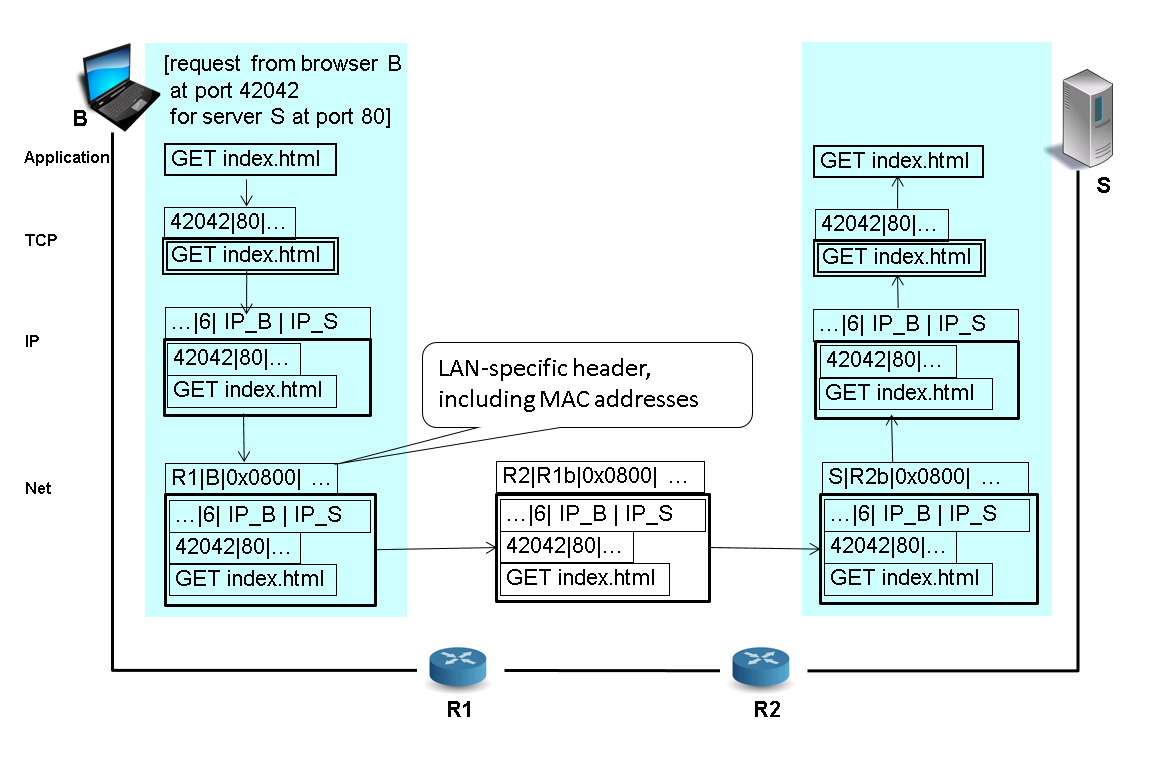
5.3 Encapsulation and Demux Keys
- Encapsulation
- Protocol specific header added for each layer
- Starting from “pure” application message
- Headers prepended when moving down the protocol stack
- Headers “unwrapped” when moving up again
- Protocol specific header added for each layer
- Demux key
- Identifies recipient protocol at next higher layer
- Different protocols use different forms of demux keys (see
previous slide)
- Ethernet header contains type field (IPv4 = 0x0800, ARP = 0x0806)
- IP header contains protocol field (TCP = 6, UDP = 17)
- TCP header contains port (application id) as demux key
5.4 Review Questions
6 Conclusions
6.1 Summary
- Computer networks are general purpose networks
- The Internet forms the backbone for modern communication and collaboration
- Complexity reduced via layered architecture
- Modular design
- Internet vs OSI architecture
- Encapsulation and demux keys
Bibliography
- [PD11] Peterson & Davie, Computer Networks, Fifth Edition: A Systems Approach, Morgan Kaufmann Publishers Inc., 2011. https://booksite.elsevier.com/9780123850591/
- [Tan02] Tanenbaum, Computer Networks, Prentice-Hall, Inc., 2002. https://www.pearson.com/us/higher-education/product/Tanenbaum-Computer-Networks-4th-Edition/9780130661029.html
License Information
This document is part of a larger course. Source code and source files are available on GitLab under free licenses.
Except where otherwise noted, the work “The Internet”, © 2018-2021 Jens Lechtenbörger, is published under the Creative Commons license CC BY-SA 4.0.

